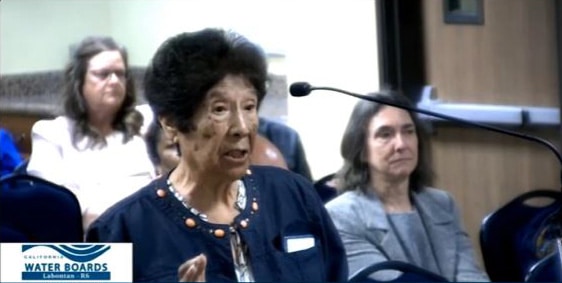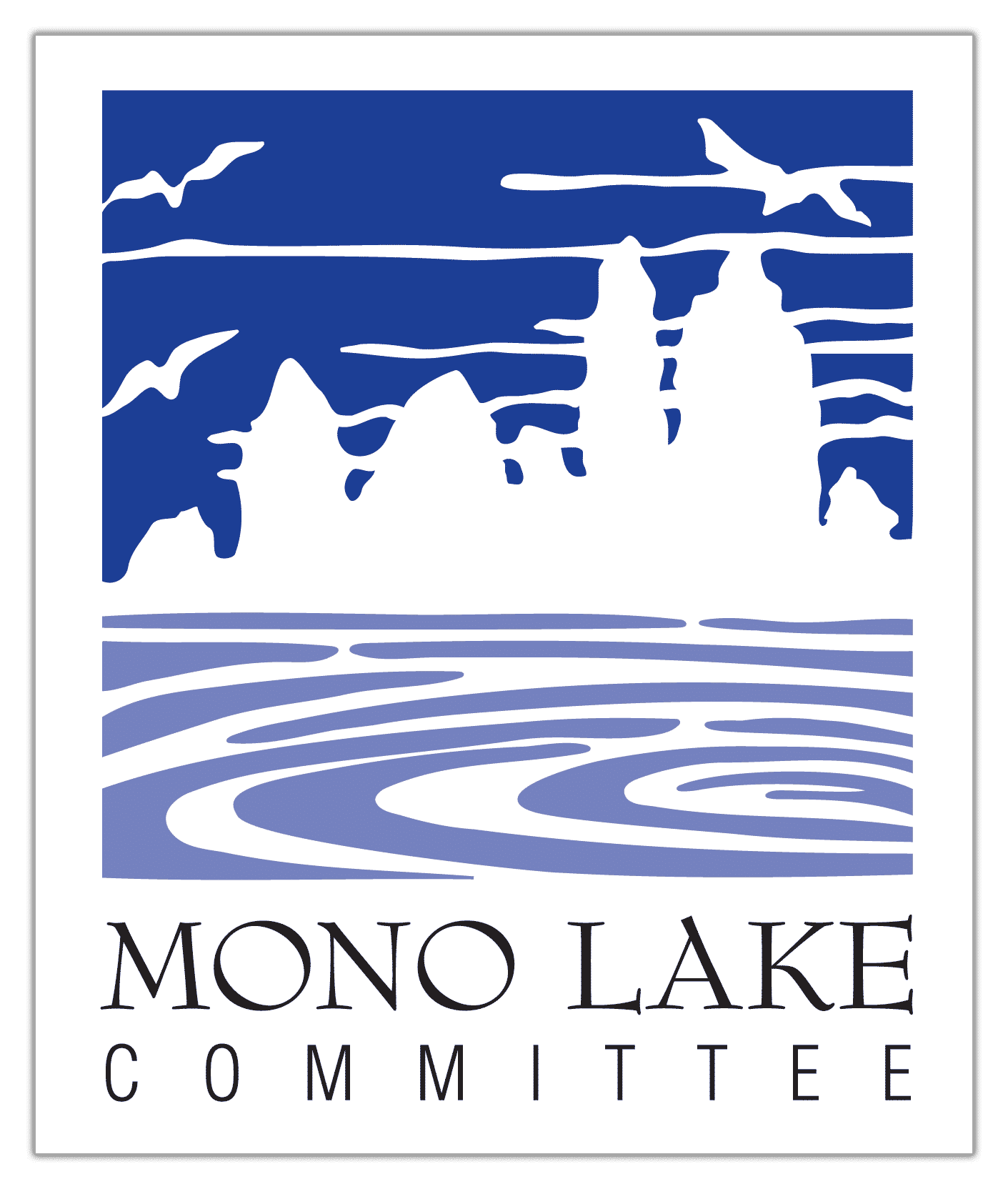
In April, an historic designation of Tribal Beneficial Uses for Mono Lake and its tributary streams moved forward. In a hearing to receive comments on the draft Mono Basin Tribal Beneficial Uses Basin Plan Amendment and environmental documentation, the Lahontan Regional Water Quality Control Board engaged in government-to-government conversation with the Mono Lake Kootzaduka’a Tribe and other Eastern Sierra Tribes and took comments from other members of the public.
Kootzaduka’a Tribe Chairwoman Charlotte Lange offered opening remarks at the hearing: “We’ve never been at the table to have conversations regarding Mono Lake or any of our traditional lands. This is a big day for us in Indian Country… Consider all you’re going to hear today. Think Indian for a day, and get our thoughts and our feelings in your heart so you can protect Mono Lake and our traditional lands.”
What are Tribal Beneficial Uses?
Under the Clean Water Act, rivers and lakes throughout the state have designated uses and water quality objectives that are established by regulators like Lahontan. In recent years California Tribes have advocated for an additional category of beneficial uses to recognize traditional cultural and Tribal subsistence uses. In 2017, the State Water Board recognized that need and defined types of Tribal Beneficial Uses (TBU) that could be applied to all inland surface waters, enclosed bays, and estuaries. The nine regional water boards are tasked with implementing TBU within their individual water quality control plans. Mono Lake and its tributary streams are the first designations to be proposed for specific water bodies, and because of this (and because it’s Mono Lake), the State Water Board has been watching this process closely.
TBU designation would recognize the traditional uses of Mono Lake, wetlands, springs, tributary streams, and high-country lakes, protecting those uses through specific water quality objectives. The uses recognized include many wide-ranging cultural and subsistence practices. The traditional harvesting of kootzabe (alkali fly pupae) from the water and shoreline of Mono Lake is a well-known practice that has nourished Indigenous peoples throughout the region for many thousands of years. Hunting, gathering food plants, and ceremonial practices are also recognized uses. Along freshwater tributary streams and high country lakes, uses include water for drinking and washing, fishing, willow-gathering for basket weaving, trade-route travel, hunting, and swimming.
Joining other beneficial uses
There are other existing categories of beneficial uses of water in California, protected under the Clean Water Act. In the Mono Basin, these categories include agricultural supply, cold freshwater habitat, commercial and sport fishing, municipal and domestic supply, navigation, inland saline water habitat, wildlife habitat, and water recreation. Multiple designations frequently coexist at Mono Lake and other water bodies that have specific, recognized uses and water quality objectives; they are part of a larger State policy of water quality control which “is directed toward achieving the highest water quality consistent with maximum benefit to people of the state.”
Beneficial uses were an important consideration in the State Water Board’s decision to raise Mono Lake to its Public Trust lake level of 6,392 feet above sea level, “to maximize the reasonable and beneficial use of California’s limited water resources.” However, the Kootzaduka’a Tribe was not formally engaged as a Tribe in the State Water Board proceedings in the early 1990s.
A formal request from the Tribe
In 2021 the Mono Lake Kootzaduka’a Tribe reached out to Lahontan and requested TBU designations for Mono Lake and its tributary streams. The Tribe’s request initiated a multi-year process that involved research, public scoping, outreach, and formal consultation with the Tribe and other Tribes in the region. The Mono Lake Committee has supported the Tribe’s request throughout. In March, Lahontan staff released a draft proposal designating TBU for Mono Lake and its tributary streams.
Hearing before the Lahontan Board
Lahontan is the regional water board that covers the largest area of California, stretching from the Oregon border to the Mojave Desert southeast of the Sierra. Its jurisdiction includes Lake Tahoe, Mono Lake, the Owens Valley, Death Valley, and points south. Board meetings occur throughout Lahontan’s region, and at the April 18 meeting in Barstow, TBU for Mono Lake were on the agenda.
The hearing was well-attended—one of the largest Lahontan has held. Members of the Kootzaduka’a Tribe as well as representatives from the Bridgeport Indian Colony, Bishop Paiute Tribe, Big Pine Paiute Tribe, and Reno Sparks Indian Colony all offered moving testimony in support of TBU.

A Kootzaduka’a elder made a presentation describing the Tribe’s use of Mono Lake and its tributary streams, sharing that “this water body is so central to our lives and heritage that we must do all that we can to ensure our lake has the utmost protections so that our lake and the ecosystem it supports are healthy and strong… it’s important to remember that we’re not thinking of ourselves, we’re thinking of also all the species that are there at Mono Lake.” The elder went on to highlight some of the present-day Tribal uses of Mono Lake, its tributary streams, and high-elevation lakes, illustrating the continuum of traditional use that occurs: “This is happening now. This isn’t just, you know, something we once did. This is something that we continue to do.”
Unanimous support
Mono Lake Committee staff traveled to Barstow to offer testimony and to support the Kootzaduka’a Tribe’s request to adopt TBU. Executive Director Geoff McQuilkin remarked, “What we just heard makes it clear that protecting Mono Lake and its tributary streams must involve the Kootzaduka’a and Indigenous peoples… Today is about expanding what California recognizes to be the purposes of protecting clean water in the first place.”
Interested parties and individuals from up and down the Eastern Sierra commented as well. The Inyo National Forest, California State Parks, Mono County Supervisor Bob Gardner, Friends of the Inyo, the Toiyabe Chapter of the Sierra Club, and Lee Vining residents all offered supporting comments.
Interested parties from Los Angeles also provided testimony supporting the Tribe and TBU designation. Communities for a Better Environment, East Yard Communities for Environmental Justice, the Sierra Club’s Water Committee and Social and Environmental Justice Committee, and the Southern California Watershed Alliance were among those recognizing the Tribe’s heritage and supporting Lahontan’s consideration of TBU.
The Los Angeles Department of Water & Power (DWP) was present at the hearing, and a representative made brief comments thanking all those who spoke, stating that DWP would be submitting its comments in writing. DWP commented previously during the scoping phase of the project in 2023, and asked that Lahontan “identify and evaluate any potential impacts that may occur to LADWP’s critical water supply and hydropower infrastructure and operations as a result of the Proposed [TBU].”
Next steps
The Lahontan board accepted written comments through April 2024, which will be considered as the board provides direction to staff completing the final proposed decision document. Once the document is released, there will be another opportunity for the Tribes and the public to provide comments. The next Lahontan Board meeting is in Lee Vining in November, when an action to designate TBU in the Mono Basin is tentatively scheduled. Other regional boards in California are also considering TBU designations, but Mono Lake is the first. The Public Trust was first implemented in California at Mono Lake, positively shaping the trajectory of water law and use in California. Now, as Tribal Beneficial Uses are considered, Mono Lake and the Kootzaduka’a Tribe can bend that trajectory further to include Indigenous people and traditional cultural practices in the eff ort to balance beneficial uses, water quality, and Public Trust values.
This post was also published as an article in the Summer 2024 Mono Lake Newsletter. Top photo by Geoff McQuilkin.
